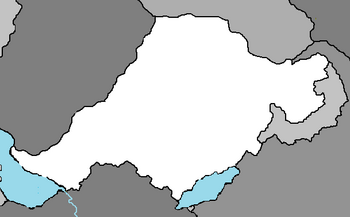East Chanchajilla
Federation of Chanchajillan Republics | |
|---|---|
|
Flag | |
 | |
| Capital | Vilanja |
| Recognised national languages | Spanish, English |
| Government | Federal Republic |
| Gideon Boer | |
| Marcus Belsia | |
| Establishment | |
• Unification of Chanchajilla | 1450 |
• Chanchajilla breaks apart | 1932 |
• Republic of Chanchajilla | 1951 |
| Population | |
• 2020 estimate | 47,800,000 |
| GDP (PPP) | estimate |
• Total | 446.708 billion |
| Gini | 32 medium |
| HDI | 0.78 high |
| Currency | Chancu Dimo |
| Time zone | UTC+4 |
| Date format | mm-dd-yyyy |
East Chanchajilla, or as it is less commonly referred to as the Republic of Chanchajilla and the official title of Federation of Chanchajillan Republics is a nation located on the continent of Euronia. It is landlocked and bordered by Mayotte (previously Zamastan) to the south, Paraboca to the north, West Chanchajilla to the west, and Birat and Avergnon in the east. The west and east had been unified as Greater Chanchajilla from their respective kingdoms since 1450, although a brutal occupation and resulting violent Parabocan War eventually eroded the social and governmental states of the nation. The separation of Chanchajilla and the ensuing Chanchajillan Civil War in 1932-44 resulted in two separate nations; east and west. East Chanchajilla, which remained a capitalist-centered economy with more political freedoms than their neighbors to the west, gained significant aid from Zamastan following the conclusion of the World War, and they provided packages that built their military, infrastructure, and economics.
East Chanchajilla is considered developing, and has a semi-industrialised economy with a well-integrated agriculture sector and a growing services sector. It is ranked among the emerging economies of the world, and is backed by one of the world's largest and fastest-growing middle class. The country continues to face challenging problems, including overpopulation, terrorism, poverty, illiteracy, and corruption. East and West have also had multiple violent and sporadic conflicts between on their border in the past century, including the South Turania Offensive and the 2021 Chanchajilla War. It is a member of the Coalition of Crown Albatross, TIDI, and the Associative Council of Neutrality.
History
Early Age
Unification of Kingdoms
Parabocan Occupation
Throughout the late 1700's and early 1800's, the military dictatorships of Paraboca thrived to conquer territory to reach their imperial boundaries to the Toyana Ocean and eventually, in a long shot endeavor, the Olympic Ocean. In 1788, the Parabocan Empire captured Vilanja after a month-long siege, ultimately annexing much of the eastern regions of Chanchajilla into their empire. Thirty years later in 1819 in another bout for resource-fueled expansion, a more aggresive push westward brought the Parabocan armies to Ivora. Throughout the next twenty years, Parabocan armies began to seize area around the Louise Mountains and eventually into indigenous Zamastanian lands in current day Aunistria, Mayotte, and Pahl, where the fledgling tribes were either conquered or retreated north towards the newly established nation of Zamastan. President Tomias Hapson established projects to house and protect fleeing indigenous refugees, one of the first refugee-crisis management projects in history.
In 1832, Paraboca invaded the Kingdom of Mayotte, seizing their southern shoreline and effectively capturing their access to the Toyana Ocean. In 1840, they moved northward and captured territory that bordered Zamastan's newly established frontier. President Hapson met with Parabocan leader Osi Jo Oberk when the latter traveled to Tofino, and aggressively talked him down from any more aggression westward, to which the Parabocans agreed. Instead of expanding southwest, the Parabocans moved directly south, capturing swaths of land up to just shy of the southern border of Avergnon.
As the manifestation of the expanse and settling of the east by Zamastanians continued in the 1850s and 60s, the Empire of Paraboca, which had recently annexed the Kingdom of Mayotte, and settlers came into occassional conflict with one another. President Elliott North in 1861 ordered Zamastanian troops to mass around the as of yet undeclared border on the frontier, which provoked the 1862 Battle of Joanah Ranch where Zamastanian settlers, soldiers, and Parabocan troops exchanged gunfire and dozens were killed. In response, the Empire began massing troops in the Mayotte region, threatening to invade Zamastan if the continued inhabitation of the newly annexed land broke into Parabocan lands. North ceased the military activity in the region, but settlers continued to create their homesteads and grow settlements in the area. Emperor Cardoza III, recognizing that the threat of the Zamastanian military had pulled away, decided that the annoyance of Zamastanian settlers would have to be a regular disturbance that he wouldn't act on for the sake of maintaining a relatively stable empire.
The dynamic greatly shifted in 1867 when President Bryson Woodward further encouraged farming and ranching in the new frontier, with the

